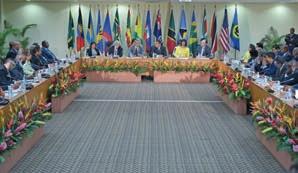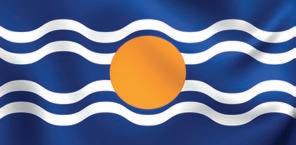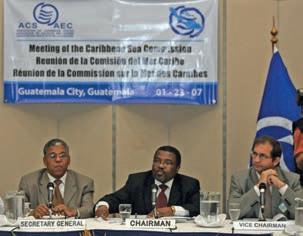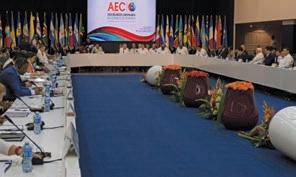3 Caribbean Social Studies
 Naam Thomas, Nicole Philip-Dowe, Lisa Greenstein, Bruce Nicholson & Daphne Paizee
Naam Thomas, Nicole Philip-Dowe, Lisa Greenstein, Bruce Nicholson & Daphne Paizee

 Naam Thomas, Nicole Philip-Dowe, Lisa Greenstein, Bruce Nicholson & Daphne Paizee
Naam Thomas, Nicole Philip-Dowe, Lisa Greenstein, Bruce Nicholson & Daphne Paizee
In this unit you will find out ❯❯
• Define relevant terms and concepts
❍ regional integration
❍ bilateral agreement
❍ cooperation
❍ dependence
❍ economy
❍ interdependence
❍ region
❍ multilateral agreement

❍ multinational corporation
• Describe the Caribbean integration process from the 1950s to the present
• Outline the objectives and membership of institutions/bodies which form part of the integration process:
❍ West Indian Federation
❍ CARIFTA
❍ CARICOM and CSME

❍ OECS
❍ Association of Caribbean States

❍ sport, education, medicine, culture, disaster preparedness



• How the individual, businesses and countries benefit from regional integration
• Examine issues that affect the Caribbean and the world and develop action plans to solve these issues:
❍ drugs, crime, HIV
❍ poverty, unemployment
❍ pollution, terrorism
We are learning to:
•define relevant terms and concepts: regional integration, bilateral agreement, cooperation, dependence, economy, interdependence, region.
Regional integration is when countries in a region cooperate and work together towards common goals. This has been a priority since the 1950s, when the first attempts were made by Caribbean states to work cooperatively towards common goals. This came about because states wanted to be less dependent on former colonial powers.
To integrate means to bring together ideas and people so that they work together or become part of the same group. The aim of integration is to give members equal status in a group and to share the advantages and strengths that the group brings. There are several types of integration:
• Social integration happens when people of different cultural backgrounds learn tolerance and respect for each other.
• Racial integration is when people of different races are treated equally so they can live and work together.
• Economic integration is achieved when two or more states in a geographic area set common economic goals and reduce the barriers to trade between them. This complements a country’s own economy, which is made up of businesses that provide goods and services to meet people’s needs.
Cooperation means working together and helping each other to achieve common goals. For example, we need to cooperate with our neighbours and other members of our community. If there is a problem in a community and everyone cooperates fully, the problem can be solved.
1. In your own words, define regional integration.
2. How many different types of integration are there? Write your own definition of each.
3. Why do you think social integration is important in Caribbean countries?

Work in groups and discuss how interdependence can help the states in the Caribbean to develop.
Do your own research in groups. Take one of the terms explained on these pages, and find out more about the term. Then look in newspapers and find examples of events that illustrate what it means. For example, a community event could illustrate integration in an area. Some news about trade between different Caribbean states could illustrate interdependence in the Caribbean region.
To depend on something is to rely on or be controlled by it. Dependence on other people has many disadvantages, because it means you are not free to do as you wish.
During colonial times, Caribbean colonies were dependent on their colonial masters (for example, the United Kingdom) and were forced to live by the social and economic laws and rules of their colonisers.
Colonies had little or no control over their own laws or the economic and social development of their own countries.
In the 1960s, when many Caribbean states gained independence, foreigners still owned much of the good farming land and also many of the businesses. The profits from these economic activities were not used to develop the Caribbean countries.
From the 1950s onwards, Caribbean states tried to lessen their dependence on their former colonial rulers in order to strengthen their economies.
Countries began to establish bilateral agreements – agreements where two countries help each other – and treaties to help develop the region as a whole.
Countries that help each other or rely on each other are interdependent. The leaders of states in the Caribbean saw interdependence as the way forward and as a means of strengthening the development of states in the region. This interdependence started in the 1950s with the West Indian Federation and continues today through organisations like CARICOM and the Association of Caribbean States (ACS).

Exercise
4. In your own words, define the terms dependence and interdependence.
5. Did the Caribbean colonies have control of their own laws when they were a Crown Colony?
6. In what way were the Caribbean colonies once dependent on the United Kingdom?
Key vocabulary
regional integration
integrate
social integration
racial integration
economic integration cooperation dependence
bilateral agreement
interdependent/ interdependence
treaty region
We are learning to:
• define relevant terms and concepts: multilateral agreement, multinational corporation
• describe the Caribbean integration process from the 1950s to the present: West Indian Federation
• outline the objectives and membership of institutions/bodies which form part of the integration process: West Indian Federation.
The first significant attempt at integration by Caribbean states took place in 1958, when 10 Caribbean countries, who were all still British colonies at the time, formed the West Indian Federation as an attempt at a political union.

The West Indian Federation was the first example in the region of an organisation that was based on multilateral agreement. A multilateral agreement usually refers to agreements between more than one country or multinational corporation (a large organisation that has business interests in more than one country). The West Indian Federation is an example of a multilateral agreement.
At the time of its formation in 1958, the membership of the West Indian Federation was:
• Antigua and Barbuda
• Barbados
• Dominica
• Jamaica
• Grenada
• St Kitts-Nevis-Anguilla
• Montserrat
• St Lucia
• St Vincent and the Grenadines
• Trinidad and Tobago.
The main aim of the Federation was to reduce dependence on (and ultimately to achieve independence from) Britain.
1. When was the West Indian Federation set up?
2. Name the members of the West Indian Federation.
3. What were the main advantages of creating a Federation?
Did you know...?
The following states were members of the Federation:
• Antigua and Barbuda
• Barbados
• Dominica
• Grenada
• Jamaica
• Montserrat
• St Kitts-NevisAnguilla
• St Vincent and the Grenadines
• St Lucia
• Trinidad and Tobago
The West Indian Federation lasted until 1962. The Federation was disbanded when Jamaica and Trinidad and Tobago decided to leave it. There were a number of reasons for this:
• Trinidad and Tobago and Jamaica were the biggest countries in the Federation and they were expected to bear most of its costs. This was considered to be unfair.
• The smaller countries feared that the more powerful countries would dominate the Federation.
• There was disagreement as to where the capital of the Federation should be.
• Jamaica objected to the colonial status of the Federation and felt that it was holding back independence from Britain.
• The most respected leaders of the time preferred to stay on as leaders in their own country, rather than lead the Federation,
• In September 1961, Jamaica held a referendum in which the people of Jamaica elected to pull out of the Federation. This led to the withdrawal of Trinidad and Tobago as well, after Dr Eric Williams famously said in a speech that ‘One from ten leaves zero.’
Exercise
4. Outline the reasons why the West Indian Federation disbanded.
5. Your teacher will play you the calypso ‘Federation’, by Mighty Sparrow. Listen carefully to the lyrics and then discuss these questions.
a) Why, in the opinion of Mighty Sparrow, did Jamaica want to pull out of the Federation?
b) What reasons did Mighty Sparrow give for the collapse of the Federation?
c) What is Mighty Sparrow’s opinion of the Federation? Was it a good thing or not?
d) Do you think Trinidad and Tobago was to blame in any way?
6. Compile a timeline of the key dates of the history of the West Indian Federation.
Activity
7.2
Do you think countries can get cheaper imports by working together? How would this work?
Key vocabulary
West Indian Federation
multilateral agreement
multinational corporation disbanded referendum
• describe the Caribbean integration process from the 1950s to the present: Association of Caribbean States
• outline the objectives and membership of institutions/bodies which form part of the integration process: Association of Caribbean States.
In 1994, the Association of Caribbean States (ACS) was set up to build on existing links in the Caribbean and to integrate the area further. The organisation was formed with the aim of promoting the interests of the Caribbean region within its member states.

The ACS was formed when US President Clinton put forward an idea for an organisation for Free Trade of the Americas (FTAA). The FTAA would encourage the movement of goods without any involvement by customs for North and South American and Caribbean countries.
Countries could not agree on the terms of the FTAA, so it was never formed. The ACS was formed in response to the proposed FTAA.
The agreement to form the Association of Caribbean States (ACS) was signed in Colombia in 1994. The Secretariat of the ACS is in Port of Spain.
In addition to the main member states, there are also associate members such as Aruba and Guadeloupe. Countries like Norway and the UK also have observer status, which means they can attend certain meetings. Currently there are 25 member states and 7 associate member states: Antigua and Barbuda, the Bahamas, Barbados, Belize, Colombia, Costa Rica, Cuba, Dominica, Dominican Republic, El Salvador, Grenada, Guatemala, Guyana, Haiti, Honduras, Jamaica, Mexico, Nicaragua, Panama, St Kitts and Nevis, St Lucia, St Vincent and the Grenadines, Suriname, Trinidad and Tobago and Venezuela.
The associate members of the ACS are as follows:
Aruba, Bonaire, Curaçao, French Guiana, Guadeloupe, Martinique, Saba, St Barthélemy, St Martin, St Eustatius, and St Maarten.
The ACS membership has identified five objectives for their organisation:
• the preservation and conservation of the Caribbean Sea – to ensure that the Caribbean region as a natural resource is protected for future generations
• sustainable tourism – protecting the environment, while developing long-term economic opportunities, which in turn creates job opportunities for the local community
• to develop greater trade between the nations
• natural disasters – to develop and put measures in place that will help protect countries and their economies in the event of a natural disaster (such as a hurricane), and to coordinate responses to natural disasters in the Caribbean
• transport – better air and sea routes between the member states and a focus on the safety of travellers in the region.
The ACS has Special Committees, each of which meet twice a year to discuss the organisation’s objectives in relation to current regional issues. The Special Committees include:
• Trade Development and External Economic Relations
• Sustainable Tourism
• Transport
• Disaster Risk Reduction
• Budget and Administration.
1. What is the main aim of the ACS?
2. Name two countries that are part of the ACS but not part of CARICOM.

3. Why do you think the preservation of the Caribbean Sea is a focus?
4. Discuss how transport within the region can strengthen economic development and cooperation.
5. What is sustainable tourism, and why is it important?
6. Write an essay with the title ‘The role of regional agencies in facilitating regional integration’. Write 250–300 words.
7.6
Compile a report summarising what you have learned about the different organisations helping to foster integration in the Caribbean. Using the internet and what you have learned so far, name the member states involved in each organisation and list two main objectives for each organisation. Create a poster showing your findings, and present them to the class.
Key vocabulary
secretariat
associate member
observer status
sustainable tourism
We are learning to:
•identify non-political areas of cooperation within the Caribbean region: sports
• assess the role of regional agencies in facilitating the integration process.
Economic affairs were not the only concern of Caribbean leaders. In order to promote unity amongst people in the Caribbean, integrated sporting events were also set up. These have proved to be most successful.
The CARIFTA Games were held for the first time in 1972. They consist of athletic field and track events, including sprints, middle-distance running races, hurdles, jumping events, throwing events and relay races between teams.
The Games are held annually. There are two categories: one for athletes under 17 years old, and the other for athletes under 20.Athletes are only allowed to compete if they are from countries that are members or associate members of CARICOM.
The CARIFTA Games were founded to improve relations between people of the English-speaking countries of the Caribbean. Since then, athletes from French- and Dutchspeaking countries have also been encouraged to take part.
The CARIFTA Games have been held in many different countries, including Trinidad and Tobago, Jamaica, Barbados, the Bahamas, Martinique, Guadeloupe, Bermuda, Grenada, Turks and Caicos, St Kitts and Nevis and St Lucia. New sports facilities have been built in many places in order to host the Games.
1. When were the CARIFTA Games first held?
2. Which sporting events feature in the CARIFTA Games?
3. What was the purpose of founding the CARIFTA Games?
4. In which countries have the Games been held?
Did you know...?
Cricket West Indies (CWI) is one of the oldest examples of regional cooperation. It was founded in the early 1920s, when it was called the West Indies Cricket Board.
Work in pairs. Visit the Cricket West Indies website (cricketwestindies.org) and research the mission, values and vision of this organisation. What do they aim to achieve?
The CARIFTA Games have been a starting point for many athletes who have gone on to become world record holders, and world and Olympic champions. These include: Usain Bolt (sprinter from Jamaica), Darrel Brown (sprinter from Trinidad and Tobago), Veronica Campbell-Brown (track and field athlete from Jamaica), Kim Collins (track and field athlete from St Kitts and Nevis), Pauline Davis-Thompson (sprinter from the Bahamas), Alleyne Francique (track athlete from Grenada) and Obadele Thompson (sprinter from Barbados).
The West Indian cricket team, commonly known as the Windies, is one of the most successful cricket teams in the world.
The team is made up of players from CARICOM countries. It competes successfully in international tournaments and is an example of the benefits of regional cooperation between CARICOM countries. Cricket West Indies encourages regional development as part of the International Cricket Council’s development programme.
Some of the best cricketers in the world come from the West Indies. Over the years, players like Sir Garfield Sobers, Gordon Greenidge, Brian Lara, Clive Lloyd, Malcolm Marshall, Sir Andy Roberts, Sir Frank Worrell, Sir Clyde Walcott, Sir Everton Weekes, Sir Curtly Ambrose, Michael Holding, Courtney Walsh, Joel Garner and Sir Viv Richards have made the Windies a force to be reckoned with.

Many players have been rewarded for their great contributions to the game of cricket.
The Windies have won the ICC Cricket World Cup, the ICC World Twenty20 and the ICC Champions Trophy. The Under 19 teams have also been successful.
5. Which countries form the West Indies cricket team?
6. Work in pairs. Find out about the medals (gold, silver and bronze) that have been won by athletes from your country in the CARIFTA Games. Find pictures of the athletes and report back to the class.
Your teacher will help you to arrange a class debate. You will discuss whether or not West Indies cricket benefits the Caribbean. Some of the class should argue that it does have benefits for the region, while others should suggest that is does not. Prepare your case and think of good reasons to back up your arguments.
We are learning to:
•identify non-political areas of cooperation within the Caribbean region: education, medicine
• assess the role of regional agencies in facilitating the integration process

This University of the West Indies (UWI) developed from the University College of the West Indies, which had been established in 1948 as an independent external college of the University of London. The UWI became completely independent in 1962, at a time when many countries in the Caribbean achieved independence. This helped in efforts to make the region more autonomous and less dependent on former colonial rulers. The UWI aids in regional development by providing tertiary education and research facilities.
UWI is internationally recognised for its excellence. Graduates of the university have helped to provide leadership in Caribbean states and to promote economic and cultural growth. Graduates of the university include many current and former prime ministers as well as Nobel laureates and Rhodes Scholars.
The university has three main campuses:
•Mona – in Jamaica
•St Augustine – in Trinidad and Tobago
•Cave Hill – in Barbados.
There are several smaller campuses in other states, as well. The Open Campus of the university provides for online learning.
The university offers diplomas and degrees in Engineering, Humanities, Education, Law, Medicine, Science, Agriculture and Social Sciences.
1. How long has UWI been a fully independent Caribbean university?
2. What courses can you study at this university?
3. Analyse the role that UWI plays in the development of the Caribbean.
Sir Derek Walcott, the Caribbean poet and playwright who won the Nobel Prize for Literature in 1992, was a graduate of the University College of the West Indies. He studied in Jamaica.